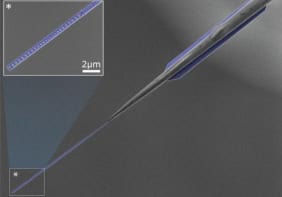Every so often, a new technology emerges from fundamental physics research that has a genuinely transformative effect on society – X-rays and the Internet being two obvious examples from history. As commentators, the tricky part is trying to predict which of today’s emerging technologies has the potential to make such an important impact on the world. But for the 25th anniversary of Physics World magazine we have attempted to do just that. We have selected a handful of spin-offs from physics research that we believe will most alter our everyday lives over the next 25 years.
This short film profiles one of these emerging technologies: the idea of using graphene to produce drinking water. Graphene – or the “wonder material” as it has become known – was first isolated just nine years ago by Andre Geim and Konstantin Novoselov at the University of Manchester in the UK. Much of the hype surrounding this 2D honeycomb of carbon atoms has focused on its extraordinary electronic properties – who could resist the lure of an ultrathin bendable smartphone? But we think that another of graphene’s physical properties could be more important still. It turns out that despite being just one atom thick, graphene appears to be completely impervious to almost every liquid and gas. By drilling holes of the appropriate size in graphene – or creating membranes of graphene flakes stuck together with just the right-sized gaps between flakes – the material can be used to filter impurities from water.
The film is shot mainly at the University of Manchester, where scientists explain why nanoporous graphene has such great potential. “Graphene is very impermeable, even very light gases don’t pass through,” explains materials scientist Sarah Haigh. “If we were able to tailor the size of the pores within the graphene lattice, it might be possible to produce a very selective filter.” Also featured in the film is Vincent Casey, technical support manager at the charity WaterAid, who believes that graphene membranes could help meet water demand in the developing world. “Over the last 40 years there has been a growing trend towards the use of reverse osmosis and membrane technology in the provision of desalinated water, whereby you move the water across a semi-permeable membrane,” he explains.
Despite realizing the vast potential that graphene membranes hold, the scientists at the University of Manchester also understand that many challenges still lie ahead in the pursuit of a robust technology. “There can be a world of difference between what happens on a small scale in the lab and what happens when you have football-fields’ worth of membrane area in a real plant,” says Peter Budd, a membrane researcher based in the university’s chemistry department. For now though, Budd remains optimistic.



